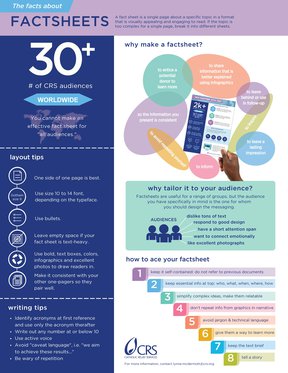
As part of being featured in the Lever for Change Bold Solutions Network, top-ranked competition applicants were asked to submit 2-page factsheets so we could effectively promote their work to potential donors and philanthropists.
While it can be a challenging process to condense a complex project into a mere 2-page document, it can also be a useful exercise for your team. The process of working together to build consensus around key messages and investment opportunities is just as important as the final product.
Factsheets are great materials to have in your communication and fundraising toolkit, but there are right and wrong ways to create these key documents. Here are some tips, tricks, and best practices to help you create the most effective factsheet for your project.
Know your audience:
- What do they care about?
- What do you want to convey to that audience?
- What do they want to know before they fund you?
- What is your audience’s appetite for technical vs. emotional content?
TIP: Create modular factsheets that let you easily swap information to better tailor content to key audiences.
Storytelling is key:
- What story do you want to tell?
- What data will help you tell that story?
- What messages, photos, and infographics can help tell that story in a compelling way?
- How can your story emphasize the impact you want to have and on whom?
TIP: Fundraising, communications, advocacy and technical teams will each bring a valuable lens to how to best tell your story effectively.
Do's and Don’ts:
DO:
- Include email, website, and social media information.
- Have a distribution plan in mind that includes all teams associated with the project.
- Review and update your factsheet often.
DON’T:
- Try to include it all.
- Use technical jargon or undefined acronyms.
- Use tiny font and a wall of text.
Great content can make up for bad design, but good design will never make up for uninteresting content.
Lynne McDermott, Senior Advisor, Communications and Marketing, Catholic Relief Services
Interested in more tips on creating effective factsheets? Explore the following resources on best practices:
1. Facts about Factsheets provides tips and tricks for creating engaging project factsheets.
2. The Facts about Fact Sheets presentation slides.
3. Factsheets Webinar provides high-level insights on creating and using project factsheets.
This post was adapted from Lever for Change’s webinar, Creating Fact-Filled Factsheets. Many thanks to our colleagues for allowing us to share their content and resources:
- Callie Johnston, Senior Director of Principal Gifts, University of Chicago Medicine and Biological Sciences Development
- Lynne McDermott, Senior Advisor, Communications and Marketing, Catholic Relief Services
- Karen Turney, Director of Development, Rice 360 Institute for Global Health
